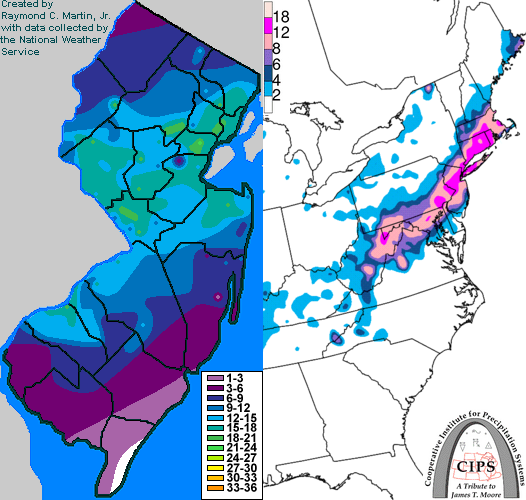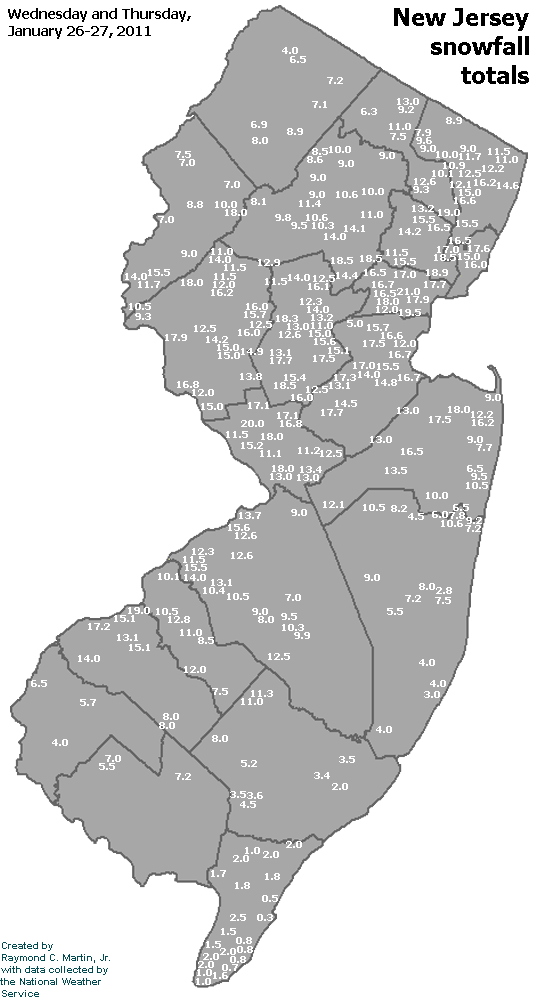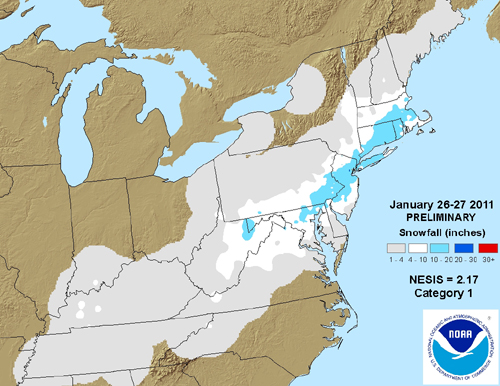

Storm description, surface observations, snowfall totals, and images courtesy of the National Climatic Data Center, the National Centers of Environmental Prediction, the Climate Prediction Center, the Hydrometeorological Prediction Center, the Mount Holly National Weather Service Office, the Upton National Weather Service Office, Rutgers University, Plymouth State University, the University of Illinois, the American Meteorological Society, Weather Graphics Technologies, AccuWeather, and the Weather Channel.
Table of Contents
Storm Summary
Regional Surface Observations
National Weather Service Forecasts
Surface Maps
Satellite Imagery
National Surface Weather Maps - Pressure and Fronts Only
Continental Surface Weather Maps - Pressure and Fronts Only
Sea Level Pressure and 1000 to 500 Millibar Thickness Maps
850 Millibar Maps
700 Millibar Maps
500 Millibar Maps
300 Millibar Maps
200 Millibar Maps
National Radar Imagery
Regional Radar Imagery
Fort Dix Doppler Radar Imagery

Contoured Snowfall Totals from January 26-27, 2011
STORM DESCRIPTION
Another storm system from the Gulf of Mexico brought a major snowstorm to much of New Jersey.
Synoptic Discussion
The low pressure system responsible for this snowstorm developed in far southern Texas during the evening hours of January 23rd. By the morning of the 24th, the low pressure was just east of the Texas Gulf coast. The low moved very slowly and only reached the coast of Louisiana on the morning of the 25th. By the evening of the 25th the low had accelerated and was located in southern Alabama. The primary low then moved northeast to eastern Tennessee by the morning of the 26th while a secondary low pressure developed near Cape Hatteras. By the evening of the 26th the two lows had coalesced back into one low pressure which was by then located just east of Delaware and was intensifying quickly. From this point the low's intensification slowed while its forward momentum increased, reaching Nova Scotia by the morning of the 27th.
Local Discussion
The first round of precipitation associated with warm air advection aloft overspread most of New Jersey just before dawn on January 26th. Precipitation from this first round was entirely in the form of rain across far southern New Jersey and was entirely in the form of snow across far northern portions of the state. In between, the snow mixed with and changed to sleet, freezing rain and rain as the day progressed. The change to rain took place in most of southeastern New Jersey by 10 AM EST, while the precipitation elsewhere mixed with sleet, freezing rain and rain as precipitation intensity decreased during the early afternoon. However, before the changeover occurred, snow had come down heavy at times during the morning across much of central and northeastern New Jersey. Another heavy round of precipitation caused by a deformation band associated with the storm's upper-level low overspread the state from west to east during the early evening. Warm air which had moved in aloft after the first round of precipitation caused this heavy precipitation to start in the form of sleet, freezing rain and rain in many areas. As cold air wrapped southward around the strengthening surface low during the mid and late evening hours, the precipitation changed to very heavy snow in most of the state with snowfall rates reaching 3 to 4 inches per hour in parts of southwestern, central and northeastern New Jersey. Thunder and lightning were also observed in many areas as this second round of snow moved across the state. Snow tapered off from west to east during the predawn hours on the 27th. Total accumulations were highest in southwestern, central and northeastern New Jersey where snow fell heavily both during the morning and again during the evening hours on the 26th. Snowfall amounts ranged from 11 to 21 inches in Essex, Hudson, Mercer, Middlesex, Morris, Somerset and Union counties, 6 to 19 inches in Bergen, Burlington, Camden, Gloucester, Hunterdon, Monmouth, Passaic and Warren counties, 2 to 11 inches in Atlantic, Cumberland, Ocean, Salem and Sussex counties and 1 to 3 inches in Cape May County. Minor tidal flooding occurred along the coast.
New Jersey Snowfall Totals

Individual Snowfall Totals from January 26-27, 2011
Regional Snowfall Totals

Snowfall Totals from January 26-27, 2011
Table of Contents
Storm Summary
Regional Surface Observations
National Weather Service Forecasts
Surface Maps
Satellite Imagery
National Surface Weather Maps - Pressure and Fronts Only
Continental Surface Weather Maps - Pressure and Fronts Only
Sea Level Pressure and 1000 to 500 Millibar Thickness Maps
850 Millibar Maps
700 Millibar Maps
500 Millibar Maps
300 Millibar Maps
200 Millibar Maps
National Radar Imagery
Regional Radar Imagery
Fort Dix Doppler Radar Imagery
Snow storm, December 26-27, 2010
Snow storm, January 7, 2011
Snow storm, January 8, 2011
Snow storm, January 11-12, 2011
Snow and ice storm, January 17-18, 2011
Snow storm, January 21, 2011
Snow and ice storm, January 26-27, 2011
Snow storm, February 21-22, 2011
Back to Ray's Winter Storm Archive
Copyright © 2011 by Raymond C Martin Jr. All rights reserved